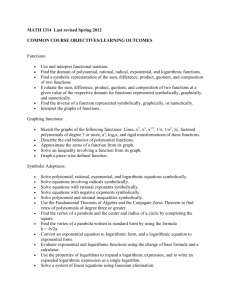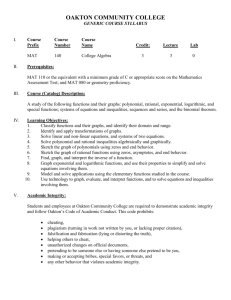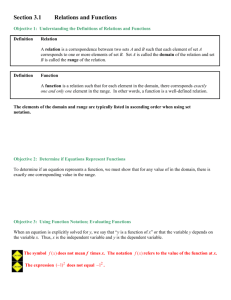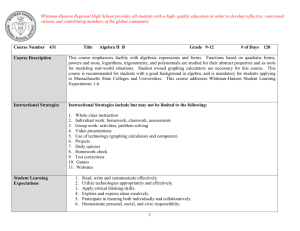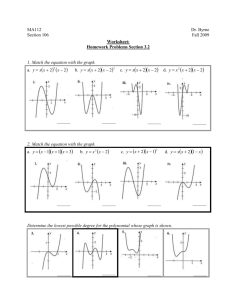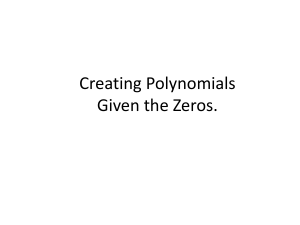Modules_August2010 - University of South Alabama
advertisement
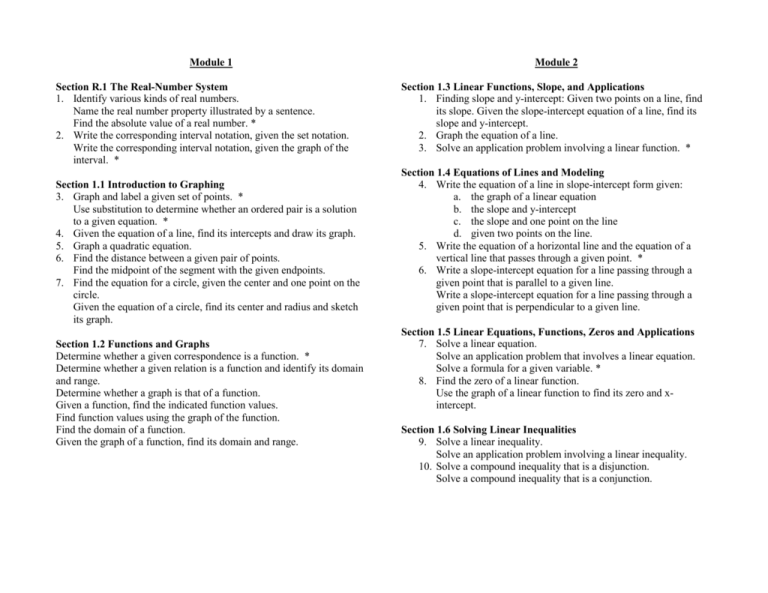
Module 1 Section R.1 The Real-Number System 1. Identify various kinds of real numbers. Name the real number property illustrated by a sentence. Find the absolute value of a real number. * 2. Write the corresponding interval notation, given the set notation. Write the corresponding interval notation, given the graph of the interval. * Section 1.1 Introduction to Graphing 3. Graph and label a given set of points. * Use substitution to determine whether an ordered pair is a solution to a given equation. * 4. Given the equation of a line, find its intercepts and draw its graph. 5. Graph a quadratic equation. 6. Find the distance between a given pair of points. Find the midpoint of the segment with the given endpoints. 7. Find the equation for a circle, given the center and one point on the circle. Given the equation of a circle, find its center and radius and sketch its graph. Section 1.2 Functions and Graphs Determine whether a given correspondence is a function. * Determine whether a given relation is a function and identify its domain and range. Determine whether a graph is that of a function. Given a function, find the indicated function values. Find function values using the graph of the function. Find the domain of a function. Given the graph of a function, find its domain and range. Module 2 Section 1.3 Linear Functions, Slope, and Applications 1. Finding slope and y-intercept: Given two points on a line, find its slope. Given the slope-intercept equation of a line, find its slope and y-intercept. 2. Graph the equation of a line. 3. Solve an application problem involving a linear function. * Section 1.4 Equations of Lines and Modeling 4. Write the equation of a line in slope-intercept form given: a. the graph of a linear equation b. the slope and y-intercept c. the slope and one point on the line d. given two points on the line. 5. Write the equation of a horizontal line and the equation of a vertical line that passes through a given point. * 6. Write a slope-intercept equation for a line passing through a given point that is parallel to a given line. Write a slope-intercept equation for a line passing through a given point that is perpendicular to a given line. Section 1.5 Linear Equations, Functions, Zeros and Applications 7. Solve a linear equation. Solve an application problem that involves a linear equation. Solve a formula for a given variable. * 8. Find the zero of a linear function. Use the graph of a linear function to find its zero and xintercept. Section 1.6 Solving Linear Inequalities 9. Solve a linear inequality. Solve an application problem involving a linear inequality. 10. Solve a compound inequality that is a disjunction. Solve a compound inequality that is a conjunction. Module 3 Section 2.1 Increasing, Decreasing and Piecewise Fns 1. Identify intervals over which the function is increasing, decreasing or constant; identify relative maxima and minima. 2. Application: area of a garden. 3. Finding the function value of a piecewise function. 4. Graphing a piecewise function. Section 2.2 The Algebra of Functions 5. Find the sum, difference, product or quotient of functions and find the domain of the above. 6. Calculate a difference quotient. (Difference quotients skipped.) Section 2.3 Composition of Functions 7. Find the composition of two functions and the domain. 8. Decompose a function as a decomposition. Section 2.4 Symmetry and Transformations 9. Identify a function as symmetric with respect to a given axis, even or odd. 10. Graph and/or write the equation for a function that has been shifted or stretched. Module 4 Section 3.1 The Complex Numbers 1. Express the square root of a negative number in terms of i. Add, subtract and multiply complex numbers. Section 3.2 Quadratic Equations, Functions, Zeros, and Models 2. Solve a factored or unfactored quadratic equation. 3. Find the x-intercepts of a parabola using its graph or equation. 4. Completing the square. 5. Using the quadratic formula to find zeros. Section 3.3 Analyzing Graphs of Quadratic Functions 6. Given the equation, find the vertex, axis of symmetry, minimum and maximum and the graph of a parabola. 7. Application problem using a parabola: height of a projectile. Application problem using a parabola: maximization. Section 3.4 Solving Rational Equations and Radical Equations 8. Solve a rational equation. Solve a radical equation. Section 3.5 Solving Equations and Inequalities with Absolute Value 9. Solve an absolute value equation with an equality. 10. Solve an absolute value equation with an inequality. Module 5 Section 4.1 Polynomial Functions and Modeling 1. Identify the degree of a factored polynomial and its common name. Identify the zeros of a factored polynomial and their multiplicity. Section 4.2 Graphing Polynomial Functions 2. Using the leading term test. 3. Graph a polynomial function (may require factoring from 4.3). 4. Intermediate value theorem. Section 4.3 Polynomial Division; Remainder and Factor Theorems 5. Use long division to test of a term is a factor. 6. Use long division to express P(x) in the form d(x)*Q(x)+R(x). 7. Factor a third of fourth degree polynomial to find the zeros. 8. Graph a polynomial function. Section 4.4 Theorems about Zeros of Polynomial Functions 9. Find one (or two) polynomials with given zeros. 10. List all possible rational zeros. Module 6 1. Be able to discern the domain for a rational function and report this domain in interval notation. 2. Be able to identify any and all asymptotes (vertical, horizontal, oblique/slant) for a given rational function and report findings as equations of lines. 3. Be able to produce a reasonable sketch of a given rational function on a grid having function labeled at the top, scale labels in all four directions from (0,0), labels in coordinate form for each axis intercept, labels for any asymptote as linear equations, and axes labels. 4. Be able to provide a candidate for a rational function given information in words describing that function graph. The given information will include axes intercepts, equations for asymptote, a function sign or value for the function on each subinterval of the Real number line having the x-intercepts or vertical asymptotes as endpoints. 5. Solve an applied problem in which the rational function is supplied. 6. Solve a polynomial inequality comparing a factored polynomial to zero in which some factors of even multiplicity appear. Solve an equality in which two rational expressions are compared. These two rational expressions must have at least one denominator factor different from the denominators of the expressions themselves. Solve a rational absolute value inequality graphically. Module 7 Section 5.1 Inverse Functions 1. Solve algebraically for the inverse of a given one-to-one function. Section 5.2 Exponential Functions and Graphs 2. Sketch a given general exponential function and explain its relationship in terms of vertical and/or horizontal shifts and reflections to the graph of a related basic exponential function. Section 5.3 Logarithmic Functions and Graphs 3. Be able to sketch two functions on a same scale set of axes and determine from the sketch whether they are likely to be inverse functions or not. 4. Produce a reasonable sketch of a general logarithmic function and label the domain and range in interval notation, the vertical asymptote as a linear equation, the x-intercept and one additional point. Section 5.4 Properties of Logarithmic Functions 5. Use the definition of the logarithm to rewrite the related exponential expression for a given logarithmic expression in order to calculate values for rational numbers expressed as logarithms. 6. State the three properties of logarithms used to rewrite logarithms of products as sums of logarithms, logarithms of quotients as differences of logarithms, and logarithms of numbers raised to powers as products of the powers and logarithms of the numbers. Section 5.5 Solving Exponential and Logarithmic Equations 7. Use properties of logarithms to rewrite sums and differences of logarithmic expressions having the same logarithm base as a single logarithm expression. 8. Use properties of logarithms, the definition of logarithms, and the one-to-one property of logarithmic and exponential functions to solve equations involving these expressions. Section 5.6 Applications & Models: Growth & Decay: Compound Interest 9. Be able to produce the correct exponential function equation or compound interest equation given the initial population, principal, or amount; continuous growth rate, doubling time, or half life; number of compounding periods per year; and yearly or period rate of interest stated in applied question form. 10. Use a given logarithmic function equation to solve for quantities requested in a stated problem.

